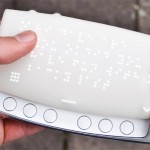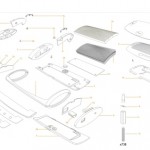AT 4 O’CLOCK each morning, Laura J. Sloate begins her daily reading. She calls a phone service that reads newspapers aloud in a synthetic voice, and she listens to The Wall Street Journal at 300 words a minute, which is nearly twice the average pace of speech. Later, an assistant reads The Financial Times to her while she uses her computer’s text-to-speech system to play The Economist aloud. She devotes one ear to the paper and the other to the magazine. The managing director of a Wall Street investment management firm, Sloate has been blind since age 6, and although she reads constantly, poring over the news and the economic reports for several hours every morning, she does not use Braille. “Knowledge goes from my ears to my brain, not from my finger to my brain,” she says. As a child she learned how the letters of the alphabet sounded, not how they appeared or felt on the page. She doesn’t think of a comma in terms of its written form but rather as “a stop on the way before continuing.” This, she says, is the future of reading for the blind. “Literacy evolves,” she told me. “When Braille was invented, in the 19th century, we had nothing else. We didn’t even have radio. At that time, blindness was a disability. Now it’s just a minor, minor impairment.”
A few decades ago, commentators predicted that the electronic age would create a postliterate generation as new forms of media eclipsed the written word. Marshall McLuhan claimed that Western culture would return to the “tribal and oral pattern.” But the decline of written language has become a reality for only the blind. Although Sloate does regret not spending more time learning to spell in her youth — she writes by dictation — she says she thinks that using Braille would have only isolated her from her sighted peers. “It’s an arcane means of communication, which for the most part should be abolished,” she told me. “It’s just not needed today.”
Braille books are expensive and cumbersome, requiring reams of thick, oversize paper. The National Braille Press, an 83-year-old publishing house in Boston, printed the Harry Potter series on its Heidelberg cylinder; the final product was 56 volumes, each nearly a foot tall. Because a single textbook can cost more than $1,000 and there’s a shortage of Braille teachers in public schools, visually impaired students often read using MP3 players, audiobooks and computer-screen-reading software.
A report released last year by the National Federation of the Blind, an advocacy group with 50,000 members, said that less than 10 percent of the 1.3 million legally blind Americans read Braille. Whereas roughly half of all blind children learned Braille in the 1950s, today that number is as low as 1 in 10, according to the report. The figures are controversial because there is debate about when a child with residual vision has “too much sight” for Braille and because the causes of blindness have changed over the decades — in recent years more blind children have multiple disabilities, because of premature births. It is clear, though, that Braille literacy has been waning for some time, even among the most intellectually capable, and the report has inspired a fervent movement to change the way blind people read. “What we’re finding are students who are very smart, very verbally able — and illiterate,” Jim Marks, a board member for the past five years of the Association on Higher Education and Disability, told me. “We stopped teaching our nation’s blind children how to read and write. We put a tape player, then a computer, on their desks. Now their writing is phonetic and butchered. They never got to learn the beauty and shape and structure of language.”
For much of the past century, blind children attended residential institutions where they learned to read by touching the words. Today, visually impaired children can be well versed in literature without knowing how to read; computer-screen-reading software will even break down each word and read the individual letters aloud. Literacy has become much harder to define, even for educators.
“If all you have in the world is what you hear people say, then your mind is limited,” Darrell Shandrow, who runs a blog called Blind Access Journal, told me. “You need written symbols to organize your mind. If you can’t feel or see the word, what does it mean? The substance is gone.” Like many Braille readers, Shandrow says that new computers, which form a single line of Braille cells at a time, will revive the code of bumps, but these devices are still extremely costly and not yet widely used. Shandrow views the decline in Braille literacy as a sign of regression, not progress: “This is like going back to the 1400s, before Gutenberg’s printing press came on the scene,” he said. “Only the scholars and monks knew how to read and write. And then there were the illiterate masses, the peasants.”
UNTIL THE 19TH CENTURY, blind people were confined to an oral culture. Some tried to read letters carved in wood or wax, formed by wire or outlined in felt with pins. Dissatisfied with such makeshift methods, Louis Braille, a student at the Royal Institute for Blind Youth in Paris, began studying a cipher language of bumps, called night writing, developed by a French Army officer so soldiers could send messages in the dark. Braille modified the code so that it could be read more efficiently — each letter or punctuation symbol is represented by a pattern of one to six dots on a matrix of three rows and two columns — and added abbreviations for commonly used words like “knowledge,” “people” and “Lord.” Endowed with a reliable method of written communication for the first time in history, blind people had a significant rise in social status, and Louis Braille was embraced as a kind of liberator and spiritual savior. With his “godlike courage,” Helen Keller wrote, Braille built a “firm stairway for millions of sense-crippled human beings to climb from hopeless darkness to the Mind Eternal.”
At the time, blindness was viewed not just as the absence of sight but also as a condition that created a separate kind of species, more innocent and malleable, not fully formed. Some scholars said that blind people spoke a different sort of language, disconnected from visual experience. In his 1933 book, “The Blind in School and Society,” the psychologist Thomas Cutsforth, who lost his sight at age 11, warned that students who were too rapidly assimilated into the sighted world would become lost in “verbal unreality.” At some residential schools, teachers avoided words that referenced color or light because, they said, students might stretch the meanings beyond sense. These theories have since been discredited, and studies have shown that blind children as young as 4 understand the difference in meaning between words like “look,” “touch” and “see.” And yet Cutsforth was not entirely misguided in his argument that sensory deprivation restructures the mind. In the 1990s, a series of brain-imaging studies revealed that the visual cortices of the blind are not rendered useless, as previously assumed. When test subjects swept their fingers over a line of Braille, they showed intense activation in the parts of the brain that typically process visual input.
These imaging studies have been cited by some educators as proof that Braille is essential for blind children’s cognitive development, as the visual cortex takes more than 20 percent of the brain. Given the brain’s plasticity, it is difficult to make the argument that one kind of reading — whether the information is absorbed by ear, finger or retina — is inherently better than another, at least with regard to cognitive function. The architecture of the brain is not fixed, and without images to process, the visual cortex can reorganize for new functions. A 2003 study in Nature Neuroscience found that blind subjects consistently surpassed sighted ones on tests of verbal memory, and their superior performance was caused, the authors suggested, by the extra processing that took place in the visual regions of their brains.
Learning to read is so entwined in the normal course of child development that it is easy to assume that our brains are naturally wired for print literacy. But humans have been reading for fewer than 6,000 years (and literacy has been widespread for no more than a century and a half). The activity of reading itself alters the anatomy of the brain. In a report released in 2009 in the journal Nature, the neuroscientist Manuel Carreiras studies illiterate former guerrillas in Colombia who, after years of combat, had abandoned their weapons, left the jungle and rejoined civilization. Carreiras compares 20 adults who had recently completed a literacy program with 22 people who had not yet begun it. In M.R.I. scans of their brains, the newly literate subjects showed more gray matter in their angular gyri, an area crucial for language processing, and more white matter in part of the corpus callosum, which links the two hemispheres. Deficiencies in these regions were previously observed in dyslexics, and the study suggests that those brain patterns weren’t the cause of their illiteracy, as had been hypothesized, but a result.
There is no doubt that literacy changes brain circuitry, but how this reorganization affects our capacity for language is still a matter of debate. In moving from written to spoken language, the greatest consequences for blind people may not be cognitive but cultural — a loss much harder to avoid. In one of the few studies of blind people’s prose, Doug Brent, a professor of communication at the University of Calgary, and his wife, Diana Brent, a teacher of visually impaired students, analyzed stories by students who didn’t use Braille but rather composed on a regular keyboard and edited by listening to their words played aloud. One 16-year-old wrote a fictional story about a character named Mark who had “sleep bombs”:
He looked in the house windo that was his da windo his dad was walking around with a mask on he took it off he opend the windo and fell on his bed sleeping mark took two bombs and tosed them in the windo the popt his dad lept up but before he could grab the mask it explodedhe fell down asleep.
In describing this story and others like it, the Brents invoked the literary scholar Walter Ong, who argued that members of literate societies think differently than members of oral societies. The act of writing, Ong said — the ability to revisit your ideas and, in the process, refine them — transformed the shape of thought. The Brents characterized the writing of many audio-only readers as disorganized, “as if all of their ideas are crammed into a container, shaken and thrown randomly onto a sheet of paper like dice onto a table.” The beginnings and endings of sentences seem arbitrary, one thought emerging in the midst of another with a kind of breathless energy. The authors concluded, “It just doesn’t seem to reflect the qualities of organized sequence and complex thought that we value in a literate society.”
OUR DEFINITION of a literate society inevitably shifts as our tools for reading and writing evolve, but the brief history of literacy for blind people makes the prospect of change particularly fraught. Since the 1820s, when Louis Braille invented his writing system — so that blind people would no longer be “despised or patronized by condescending sighted people,” as he put it — there has always been, among blind people, a political and even moral dimension to learning to read. Braille is viewed by many as a mark of independence, a sign that blind people have moved away from an oral culture seen as primitive and isolating. In recent years, however, this narrative has been complicated. Schoolchildren in developed countries, like the U.S. and Britain, are now thought to have lower Braille literacy than those in developing ones, like Indonesia and Botswana, where there are few alternatives to Braille. Tim Connell, the managing director of an assistive-technology company in Australia, told me that he has heard this described as “one of the advantages of being poor.”
Braille readers do not deny that new reading technology has been transformative, but Braille looms so large in the mythology of blindness that it has assumed a kind of talismanic status. Those who have residual vision and still try to read print — very slowly or by holding the page an inch or two from their faces — are generally frowned upon by the National Federation of the Blind, which fashions itself as the leader of a civil rights movement for the blind. Its president, Marc Maurer, a voracious reader, compares Louis Braille to Abraham Lincoln. At the annual convention for the federation, held at a Detroit Marriott last July, I heard the mantra “listening is not literacy” repeated everywhere, from panels on the Braille crisis to conversations among middle-school girls. Horror stories circulating around the convention featured children who don’t know what a paragraph is or why we capitalize letters or that “happily ever after” is made up of three separate words.
Declaring your own illiteracy seemed to be a rite of passage. A vice president of the federation, Fredric Schroeder, served as commissioner of the Rehabilitation Services Administration under President Clinton and relies primarily on audio technologies. He was openly repentant about his lack of reading skills. “I am now over 50 years old, and it wasn’t until two months ago that I realized that ‘dissent,’ to disagree, is different than ‘descent,’ to lower something,” he told me. “I’m functionally illiterate. People say, ‘Oh, no, you’re not.’ Yes, I am. I’m sorry about it, but I’m not embarrassed to admit it.”
While people like Laura Sloate or the governor of New York, David A. Paterson, who also reads by listening, may be able to achieve without the help of Braille, their success requires accommodations that many cannot afford. Like Sloate, Paterson dictates his memos, and his staff members select pertinent newspaper articles for him and read them aloud on his voice mail every morning. (He calls himself “overassimilated” and told me that as a child he was “mainstreamed so much that I psychologically got the message that I’m not really supposed to be blind.”) Among people with fewer resources, Braille-readers tend to form the blind elite, in part because it is more plausible for a blind person to find work doing intellectual rather than manual labor.
A 1996 study showed that of a sample of visually impaired adults, those who learned Braille as children were more than twice as likely to be employed as those who had not. At the convention this statistic was frequently cited with pride, so much so that those who didn’t know Braille were sometimes made to feel like outsiders. “There is definitely a sense of peer pressure from the older guard,” James Brown, a 35-year-old who reads using text-to-speech software, told me. “If we could live in our own little Braille world, then that’d be perfect,” he added. “But we live in a visual world.”
When deaf people began getting cochlear implants in the late 1980s, many in the deaf community felt betrayed. The new technology pushed people to think of the disability in a new way — as an identity and a culture. Technology has changed the nature of many disabilities, lifting the burdens but also complicating people’s sense of what is physically natural, because bodies can so often be tweaked until “fixed.” Arielle Silverman, a graduate student at the convention who has been blind since birth, told me that if she had the choice to have vision, she was not sure she would take it. Recently she purchased a pocket-size reading machine that takes photographs of text and then reads the words aloud, and she said she thought of vision like that, as “just another piece of technology.”
The modern history of blind people is in many ways a history of reading, with the scope of the disability — the extent to which you are viewed as ignorant or civilized, helpless or independent — determined largely by your ability to access the printed word. For 150 years, Braille books were designed to function as much as possible like print books. But now the computer has essentially done away with the limits of form, because information, once it has been digitized, can be conveyed through sound or touch. For sighted people, the transition from print to digital text has been relatively subtle, but for many blind people the shift to computerized speech is an unwelcome and uncharted experiment. In grappling with what has been lost, several federation members recited to me various takes on the classic expression Scripta manent, verba volant: What is written remains, what is spoken vanishes into air.







